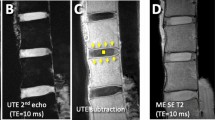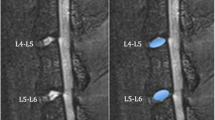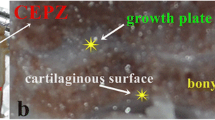Abstract
Purpose
The cartilaginous endplate (CEP) is a thin layer of hyaline cartilage positioned between the vertebral endplate and nucleus pulposus (NP) that functions both as a mechanical barrier and as a gateway for nutrient transport into the disc. Despite its critical role in disc nutrition and degeneration, the morphology of the CEP has not been well characterized. The objective of this study was to visualize and report observations of the CEP three-dimensional morphology, and quantify CEP thickness using an MRI FLASH (fast low-angle shot) pulse sequence.
Methods
MR imaging of ex vivo human cadaveric lumbar spine segments (N = 17) was performed in a 7T MRI scanner with sequence parameters that were selected by utilizing high-resolution T1 mapping, and an analytical MRI signal model to optimize image contrast between CEP and NP. The CEP thickness at five locations along the mid-sagittal AP direction (center, 5 mm, 10 mm off-center towards anterior and posterior) was measured, and analyzed using two-way ANOVA and a post hoc Bonferonni test. For further investigation, six in vivo volunteers were imaged with a similar sequence in a 3T MRI scanner. In addition, decalcified and undecalcified histology was performed, which confirmed that the FLASH sequence successfully detected the CEP.
Results
CEP thickness determined by MRI in the mid-sagittal plane across all lumbar disc levels and locations was 0.77 ± 0.24 mm ex vivo. The CEP thickness was not different across disc levels, but was thinner toward the center of the disc.
Conclusions
This study demonstrates the potential of MRI FLASH imaging for structural quantification of the CEP geometry, which may be developed as a technique to evaluate changes in the CEP with disc degeneration in future applications.






Similar content being viewed by others
References
Ferguson SJ, Steffen T (2003) Biomechanics of the aging spine. Eur Spine J 12:S97–103
Adams MA, Dolan P (2005) Spine biomechanics. J Biomech 38:1972–1983
Louma K, Riihimaki H, Luukkonen R et al (2000) Low back pain in relation to lumbar disc degeneration. Spine 24:487–492
Peng B, Hou S, Wu W et al (2006) The pathogenesis and clinical significance of a high-intensity zone (HIZ) of lumbar intervertebral disc on MR imaging in the patient with discogenic low back pain. Eur Spine J 15:583–587
Videman T, Nurminen M (2004) The occurrence of annular tears and their relation to lifetime back pain history: a cadaveric study using barium sulfate discography. Spine 29:2668–2676
Raj PP (2008) Intervertebral disc: anatomy-physiology-pathophysiology-treatment. Pain Practice 8:18–44
Roberts S, Menage J, Urban JPG (1989) Biomechanical and structural properties of the catilage end-plate and its relation to the intervertebral disc. Spine 14:166–174
Francois RJ, Bywaters EGL, Aufdermaur M (1985) Illustrated glossary for spinal anatomy. Rheumatol Int 5:241–245
Crock HV, Goldwasser M (1984) Anatomic studies of the circulation in the region of the vertebral end-plate in adult greyhound dogs. Spine 9:702–706
Roberts S, Menage J, Einstein SM (1993) The cartilage end-plate and intervertebral disc in scoliosis: calcification and other sequelae. J Ortho Res 11:747–757
Moore RJ (2000) The vertebral end-plate: what do we know? Eur Spine J 9:92–96
Urban JPG, Roberts S (2003) Degeneration of the intervertebral disc. Arthr Res Therapy 5:120–130
Grignon B, Grignon Y, Mainard D et al (2000) The structure of the cartilaginous end-plates in elder people. Surg Radiol Anat 22:13–19
Bibby SRS, Jones DA, Lee RB et al (2001) The pathophysiology of the intervertebral disc. Joint Bone Spine 68:537–542
Nachemson A, Lewin T, Maroudas A et al (1970) In vitro diffusion of dye through the end-plates and annulus fibrosus of human lumbar intervertebral discs. Acta Orthop Scand 41:589–607
Roberts S, Urban JPG, Evans H et al (1996) Transport properties of the human cartilage endplate in relation to its composition and calcification. Spine 21:415–420
Accadbled F, Laffosse J-M, Ambard D et al (2008) Influence of location, fluid flow direction, and tissue maturity on the macroscopic permeability of cerebral end plates. Spine 33:612–619
Bernick S, Cailliet R (1982) Vertebral end-plate changes with aging of human vertebrae. Spine 7:97–102
Benneker LM, Heini PF, Alini M et al (2005) Vertebral endplate marrow contact channel occlusions and intervertebral disc degeneration. Spine 30:167–173
Martin MD, Boxell CM (2002) Pathophysiology of lumbar disc degeneration: a review of the literature. Neurosurg Focus 13:1–6
Adams MA, Roughley PJ (2006) What is intervertebral disc degeneration, and what causes it? Spine 31:2151–2161
Ariga K, Miyamoto S, Nakase T et al (2001) The relationship between apoptosis of endplate chondrocytes and aging and degeneration of the intervertebral disc. Spine 26:2414–2420
Lyons G, Einstein SM, Sweet MBE (1981) Biochemical changes in intervertebral disc degeneration. Biochimica et Biophys Acta 673:443–453
Antoniu J, Mwale F, Demers CN et al (2006) Quantitative magnetic resonance imaging of enzymatically induced degeneration of the nucleus pulposus of intervertebral discs. Spine 31:1547–1554
Pfirrmann CWA, Metzdorf A, Elfering A et al (2006) Effect of aging and degeneration on disc volume and shape: a quantitative study in asymptomatic volunteers. J Ortho Res 24:1086–1094
Johannessen W, Auerbach JD, Wheaton AJ et al (2006) Assessment of human disc degeneration and proteoglycan content using T1rho-weighted magnetic resonance imaging. Spine 31:1253–1257
Blumenkrantz G, Zuo J, Li X et al (2010) In vivo 3.0-Tesla magnetic resonance T1rho and T2 relaxation mapping in subjects with intervertebral disc degeneration and clinical symptoms. Magn Reson Med 63:1193–1200
Haase A, Frahm J, Matthaei D et al (1986) FLASH imaging. Rapid NMR imaging using low flip-angle pulses. JMR 67(2):258–266
Gatehouse PD, He T, Hughes SPF et al (2004) MR imaging of degenerative disc disease in the lumbar spine with ultrashort TE pulse sequences. MAGMA 16:160–166
Dathe H, Helms G (2010) Exact algebraization of the signal equation of spoiled gradient echo MRI. Phys Med Biol 55:4231–4245
Helms G, Dathe H, Dechent P (2008) Quantitative FLASH MRI at 3T using a rational approximation of the Ernst equation. Magn Reson Med 59:667–672
Iatridis JC, Setton LA, Weidenbaum M et al (1997) The viscoelastic behavior of the non-degenerate human lumbar nucleus pulposus in shear. J Biomech 30(10):1005–1013
Rodriguez AG, Slichter CK, Acosta FL et al (2011) Human disc nucleus properties and vertebral endplate permeability. Spine 36(7):512–520
O’Connell GD, Vresilovic EJ, Elliott DM (2011) Human intervertebral disc internal strain in compression: the effect of disc region, loading position, and degeneration. J Orthop Res 29(4):547–555
Wright AC, Lemdiasov R, Connick TJ et al (2011) Helmholtz-pair transmit coil with integrated receive array for high-resolution MRI of trabecular bone in the distal tibia at 7T. J Magn Reson 210:113–122
Rosset A, Spadola L, Ratib O (2004) OsiriX: an open-source software for navigating in multidimensional DICOM images. J Digital Imaging 17:205–216
Bae WC, Statum S, Zhang Z et al (2013) Morphology of the cartilaginous endplates in human intervertebral disks with ultrashort echo time MR imaging. Radiology 266(2):564–574
Acknowledgments
This work is supported by NIH grants RC1 AR058450 and R01 AR050052.
Conflict of interest
None.
Author information
Authors and Affiliations
Corresponding author
Rights and permissions
About this article
Cite this article
Moon, S.M., Yoder, J.H., Wright, A.C. et al. Evaluation of intervertebral disc cartilaginous endplate structure using magnetic resonance imaging. Eur Spine J 22, 1820–1828 (2013). https://doi.org/10.1007/s00586-013-2798-1
Received:
Revised:
Accepted:
Published:
Issue Date:
DOI: https://doi.org/10.1007/s00586-013-2798-1




